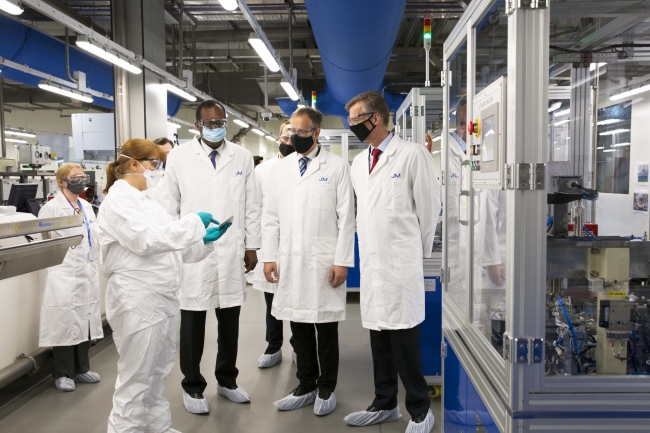3 minute read
Johnson Matthey opens new Battery Technology Centre
Johnson Matthey has opened its new state-of-the-art Battery Technology Centre near Oxford, enabling it to drive rapid improvements in battery performance and sustainable, secure value chains. The global leader in sustainable technologies also announced a further strategic development in the commercialisation of eLNO®, its portfolio of nickel-rich advanced cathode materials.
The new Battery Technology Centre will play a key role in developing battery materials of the future. It enhances Johnson Matthey’s existing battery technology capabilities and testing capacity, accelerating the further development and customisation of its eLNO® materials for battery electric vehicle applications.
Amidst the ongoing debate about the carbon intensity of battery production, Johnson Matthey has also announced that the production of eLNO® will be carbon neutral by 2035.

Johnson Matthey has opened its new battery technology centre in Oxford, and announced a commitment to be net zero by 2040 / Picture: Johnson Matthey
Furthermore, Johnson Matthey has pledged to be net zero by 2040, with the following science-based targets:
• An absolute reduction in Scope 1 and Scope 2 greenhouse gas (GHG) emissions of at least 33% by 2030.
• An absolute reduction of upstream Scope 3 GHG emissions of at least 20% by 2030.
Robert MacLeod, chief executive of Johnson Matthey, said: “This new facility represents an important milestone on our journey towards developing a sustainable battery materials ecosystem and emphasises the progress we are making on the commercialisation of our battery materials business. Johnson Matthey has a growing range of solutions to help society decarbonise at scale, and at the same time we are doing our bit by driving our own operations and supply chains to achieve net zero by 2040.”
Christian Günther, chief executive of its battery materials business, continued: “We’re thrilled to open our Battery Technology Centre. It has a dedicated, on site product development team which will enable more rapid customisation of our eLNO® cathode materials to meet our customers’ needs. It also boasts advanced material characterisation and diagnostic equipment that enable both engineering on an atomic level and evaluation under realistic conditions. This new Battery Technology Centre is a big step forward in delivering eLNO® to the market.”
Business secretary Kwasi Kwarteng opened the new centre and concluded: “This centre has a vital role to play in our plans to drive forward new, cost-effective technology that will make adopting electric vehicles more convenient for motorists as we transition away from diesel and petrol cars.
“As Business Secretary, it is a personal commitment of mine to ensure the UK continues to be one of the best locations in the world for automotive manufacturing. In order to protect and create jobs in our industrial heartlands, while securing a competitive future for the auto sector and supply chain, we need to throw our weight behind battery innovation and commercialisation to support the sector’s transition to a clean, green future.”
Johnson Matthey’s scope emissions explained:
Scope 1 covers direct greenhouse emissions from owned or controlled sources.
Scope 2 covers indirect emissions from the generation of purchased electricity, steam, heating and cooling consumed by the reporting company.
Scope 3 includes purchased goods and services.